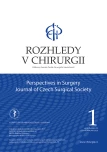Instrumentation of C1 lateral mass via insertion of the posterior arch of atlas – a morphometric study
Authors:
P. Barsa 1; M. Šercl 2; P. Suchomel 1
Authors‘ workplace:
Neurochirurgické oddělení, Neurocentrum, Krajská nemocnice Liberec, a. s.
1; Radiodiagnostické oddělení, Krajská nemocnice Liberec, a. s.
2
Published in:
Rozhl. Chir., 2020, roč. 99, č. 1, s. 34-37.
Category:
Original articles
doi:
https://doi.org/10.33699/PIS.2020.99.1.34–37
Overview
Introduction: Instrumentation of the lateral mass of atlas via posterior arch attachment (PALMS) is a method that, unlike the traditional direct screw insertion into the lateral mass, prevents damage to the periarticular venous plexus and C2 nerve root. The method itself may be, however, limited by the anatomical situation. The small cranio-caudal pedicle dimension may lead to vertebral artery damage. The aim of this study was to use morphometric examination of CT findings from the healthy population to evaluate theoretical feasibility of this technique in a randomly selected population sample.
Methods: Morphometric measurements determining dimensions of C1 pedicle at the site of expected screw insertion were performed on reformatted parasagittal CT scans of 42 healthy probands. Using the software of the Jivex browser, we measured the minimum height of posterior arch insertion under the vertebral artery groove and evaluated the possibility of introducing 3.5 mm and 4 mm screws.
Results: The mean minimum height of the critical segment was calculated as 4.29 mm (left insertion 4.28 mm, right insertion 4.31 mm, range 3.02–5.62 mm). Despite the highest size in a female and the lowest in a male, the male population showed larger bone stock (mean of 4.71 mm: left connection 4.70 mm, right connection 4.71 mm) than the female one (mean of 4.29 mm: left 4.28 mm, right 4.31 mm). Overall, we found 59.5% insertions higher than 4 mm and 86.9% arch connections bigger than 3.5 mm.
Conclusion: The anatomical situation allows inserting at least a 3.5mm diameter screw in a vast majority of cases. The posterior arch attachment point thus seems to be a suitable anatomical target for instrumentation of C1 lateral mass. Nevertheless, individual presurgical planning and intraoperative spinal navigation should be implemented, as well.
Keywords:
atlas – lateral mass – Morphometry – surgical treatment – internal fixation
Sources
- Goel A, Laheri V. Plate and screw fixation for atlanto-axial subluxation. Acta Neurochir. (Wien) 1994;129(1–2):47–53. doi: 10.1007/bf01400872.
- Harms J, Melcher RP. Posterior C1-C2 fusion with polyaxial screw and rod fixation. Spine 2001;26(22):2467–2471. doi:10.1097/00007632-200111150-00014.
- Resnick DK, Lapsiwala S, Trost GR. Anatomic suitability of the C1–C2 complex for pedicle screw fixation. Spine 2002;27(14):1494–1498. doi:10.1097/00007632-200207150-00003.
- Tan M, Wang H, Wang Y, et al. Morphometric evaluation of screw fixation in atlas via posterior arch and lateral mass. Spine 2003;28(9):888–95. doi:10.1097/01.BRS.0000058719.48596.CC.
- Lee MJ, Cassinelli E, Riew KD. The feasibility of inserting atlas lateral mass screws via the posterior arch. Spine 2006;31(24):2798–2801. doi:10.1097/01.brs.0000245902.93084.12.
- Ma XY, Yin QS, Wu ZH, et al. Anatomic considerations for the pedicle screw placement in the first cervical vertebra. Spine 2005;30(13):1519–1523. doi:10.1097/01.brs.0000168546.17788.49.
- Christensen DM, Eastlack RK, Lynch JJ, et al. C1 anatomy and dimensions relative to lateral mass screw placement. Spine 2007;32(8):844–8. doi:10.1097/01.brs.0000259833.02179.c0.
- Qian L-X, Hao D-J, He B-R, et al. Morphology of the atlas pedicle revisited: a morphometric CT-based study on 120 patients. Eur Spine J. 2013; 22(5):1142–6. doi:10.1007/s00586-013-2662-3.
Labels
Surgery Orthopaedics Trauma surgeryArticle was published in
Perspectives in Surgery

2020 Issue 1
Most read in this issue
- A review of possible complications in patients after decompressive craniectomy
- Atlanto-occipital dissociation
- Transpedikulární fixace s augmentovanými fenestrovanými šrouby u osteoporotických fraktur páteře
- History, development and use of classification of thoracolumbar spine fractures
